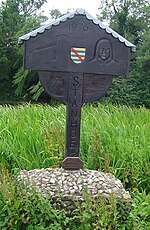Bagthorpe, Norfolk
Former civil parishes in NorfolkKing's Lynn and West NorfolkNorfolk geography stubsOpenDomesdayVillages in Norfolk

Bagthorpe is a village and former civil parish, now in the parish of Bagthorpe with Barmer, in the King's Lynn and West Norfolk district, in the county of in Norfolk, England. In 1931 the parish had a population of 68. On 1 April 1935 the parish was abolished to form "Bagthorpe with Barmer". The name of the village derives from 'Bakki's/Bak's outlying farm/settlement' or 'Bacca's outlying farm/settlement'. Although this is uncertain.
Excerpt from the Wikipedia article Bagthorpe, Norfolk (License: CC BY-SA 3.0, Authors, Images).Bagthorpe, Norfolk
Crow Lane, King's Lynn and West Norfolk Bircham
Geographical coordinates (GPS) Address Nearby Places Show on map
Geographical coordinates (GPS)
| Latitude | Longitude |
|---|---|
| N 52.85 ° | E 0.65 ° |
Address
Crow Lane
Crow Lane
PE31 6SX King's Lynn and West Norfolk, Bircham
England, United Kingdom
Open on Google Maps








